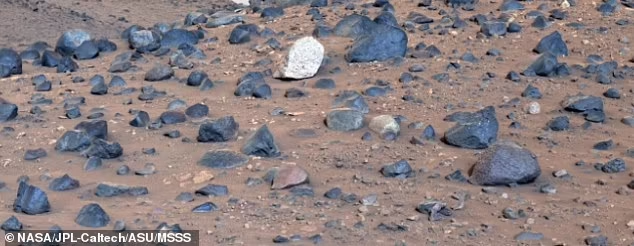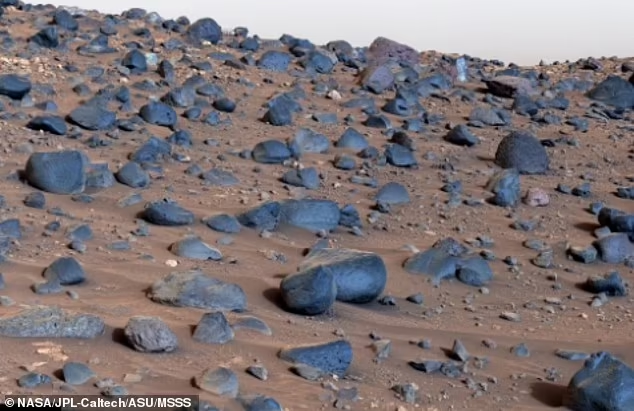NASA published the clearest photo of Mars
- October 10, 2024
- 0
NASA has released the clearest image of Mars to date; Blue rocks are seen in the Martian landscape. The images taken by the Perseverance rover during the expedition
NASA has released the clearest image of Mars to date; Blue rocks are seen in the Martian landscape. The images taken by the Perseverance rover during the expedition

NASA has released the clearest image of Mars to date; Blue rocks are seen in the Martian landscape. The images taken by the Perseverance rover during the expedition also show a “first of its kind” geological formation standing on the dried remains of an ancient lake. Dark blue, jagged volcanic basalt rocks were seen around the mottled white rock; It turns out that the mineral composition is unlike those seen on Mars.
The expedition named this rocky area Mount Washburn, after a mountain in Yellowstone National Park. About 3.7 billion years ago, there was a flow of water into the Lake, as evidenced by the presence of a paleolake and a long river delta with a diameter of 45 km along the edge of the crater. These rivers brought to the Lake fine-grained sand and mud of a consistency known to preserve fossils on Earth: the fine clay that the Perseverance probe was sent to investigate because NASA believes the crater may have once supported life.
“Sometimes we see something strange in the Martian landscape. The team said, ‘Oh, let’s go there,'” said Dr. Kathy Stack Morgan, a planetary scientist at NASA’s Jet Propulsion Laboratory.

Many of the blue-black rocks seen on the surface of Mars, such as Mount Washburn, are volcanic basalt. “Mars consists mainly of rocks similar to Earth’s basalts, called tholeites. They form most of the oceanic islands, mid-ocean ridges, and the seafloor under precipitation. [на Землі]” explained planetary scientist and geophysicist Jeffrey Taylor of the University of Hawaii.
However, a prominent white-speckled rock in the middle of this basalt surprised NASA’s Perseverance team. Perseverance captured the image using Mastcam-Z, an array of cameras mounted at human eye level on a 1.5-meter pole at the top of the rover. Mastcam-Z provides a sharp image of this rock formation, providing 2-megapixel quality that is “similar to a consumer digital camera,” according to the space agency’s specifications.
The camera’s 3D images provide a resolution of 0.0059 inches per pixel at close range and 0.3 inches per pixel at maximum magnification. NASA named the striking white rock, approximately 18 inches (0.4572 meters) wide and 14 inches (0.3556 meters) high, Atoko Point, after the 8,000-foot-tall cliff in the Grand Canyon.
However, it was the full suite of chemical and geological analysis tools that the SuperCam robot had that helped determine just how unique the Atoko Point discovery truly was. Dr. SuperCam’s two lasers and four spectrometers detected enough feldspar to confirm that the white rock is anorthosite, a type of rock long predicted to exist on Mars but never before seen, Stack Morgan said.
Like basalts, anorthosites are volcanic rocks, but they contain more silicon compounds, suggesting that this stone may have emerged deeper below the surface than its rocks. Additional anorthosite samples could help determine whether Atoko Point was drawn into the crater by ancient rivers, formed below the surface through lava, or was perhaps pulled to the surface by the impact that formed Crater Lake billions of years ago.
A researcher at NASA’s Jet Propulsion Laboratory and deputy project scientist on NASA’s Mars 2020 mission, which launched Perseverance years ago, said he hopes these rock-like new findings will reveal details about what’s currently under the Martian surface. and how the planet formed: “If we then look at other rocks, we can get an idea of how the early crust of Mars was formed.”
Source: Port Altele
As an experienced journalist and author, Mary has been reporting on the latest news and trends for over 5 years. With a passion for uncovering the stories behind the headlines, Mary has earned a reputation as a trusted voice in the world of journalism. Her writing style is insightful, engaging and thought-provoking, as she takes a deep dive into the most pressing issues of our time.